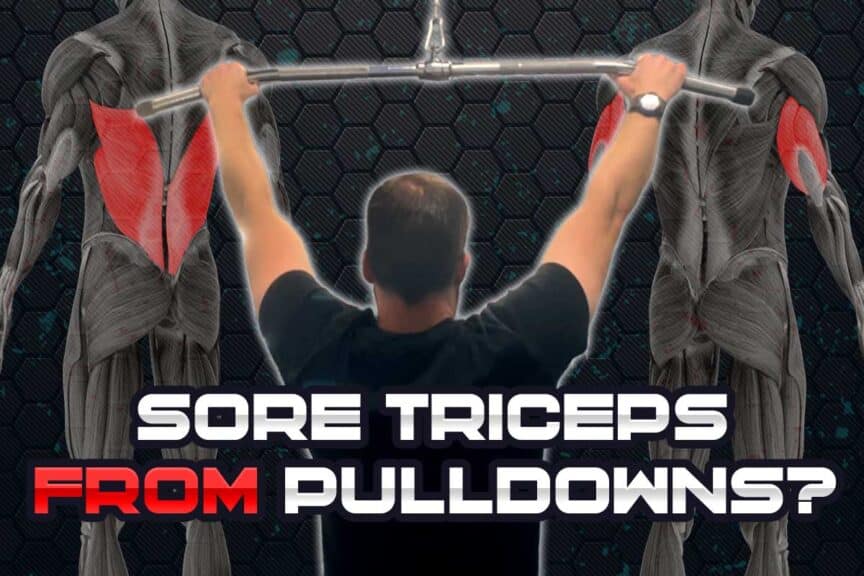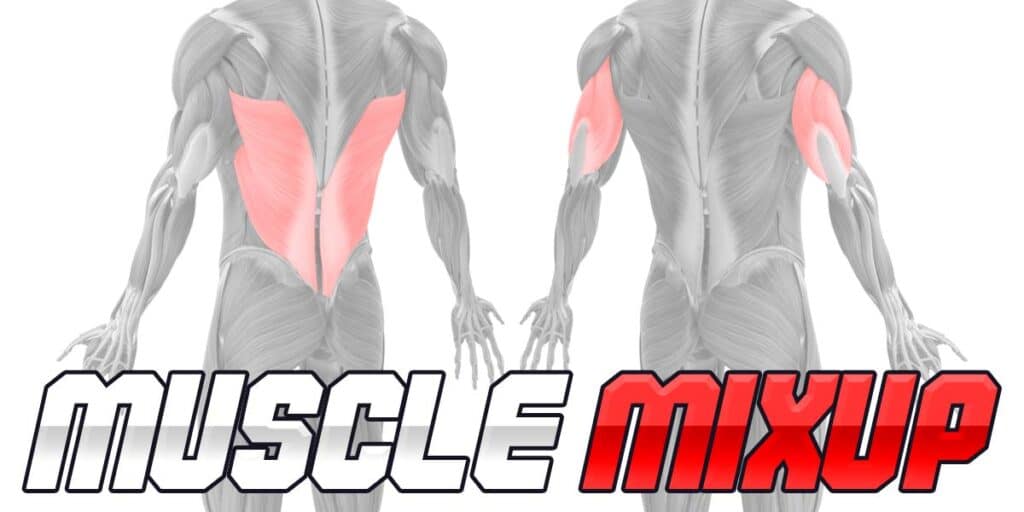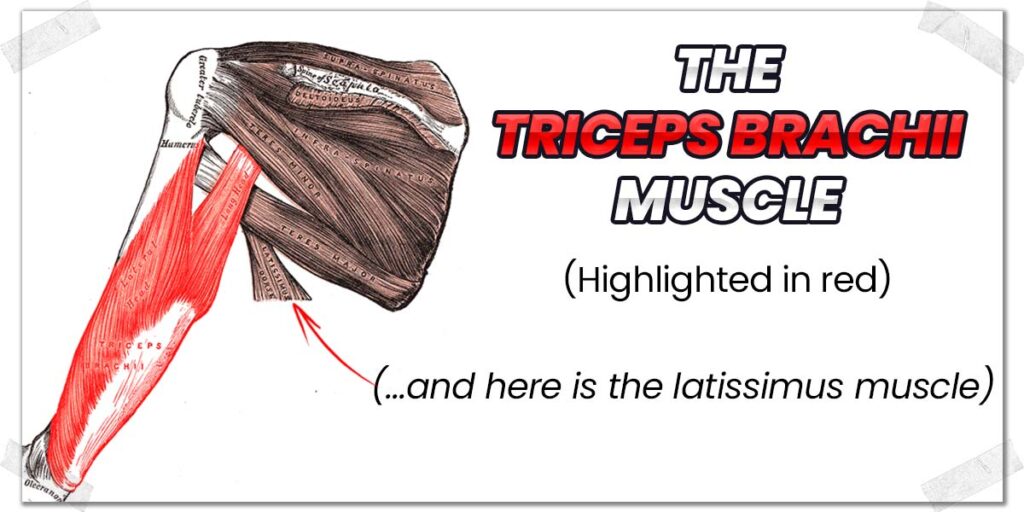There’s nothing quite like banging out some challenging lat pulldowns; it’s such a good feeling. But why on earth would it make your triceps sore? Lat pulldowns are a back exercise, after all. Well, let’s talk a bit about anatomy in this article, and it then will all make perfect sense.
I’ll also provide some lat pulldown modifications you can try so that you can keep challenging your lats in ways they’re not accustomed to being stimulated!
Sore triceps from lat pulldowns often isn’t soreness in the triceps—it’s soreness in the upper lats; the lat muscle attaches onto the upper humerus right next to the medial and lateral triceps heads. With these muscle insertion points being so close to one another, the soreness is misinterpreted.
Two of the three triceps heads don’t even cross the shoulder joint at all, so there is really no way they can assist with the pulldown (meaning pulldowns won’t make them sore).
Now, if you want some really geeky anatomy, we can talk about the long head of the triceps muscle; that one could theoretically get a bit sore since it crosses the back of the shoulder joint and attaches to the supraglenoid tubercle of the scapula. Yeah, geeky, right? (But totally cool!) So, we’ll talk about why it could potentially get a bit sore.
Related article: The Best Renegade Row Alternatives: Five Awesome Variations to Try
Understanding myalgic discomfort
Myalgia refers to pain or discomfort arising from a muscle (or multiple muscles). The soreness that’s often felt following a strength training workout is an example of myalgic discomfort. It is a sub-classification of somatic pain, which refers to pain detected from the nerves within muscles, tendons, and bones.
The thing with myalgic discomfort or pain, in particular, is that it can sometimes be hard for the brain to localize and interpret absolute precise regions from where the discomfort arises.
Since the latissimus dorsi dives directly underneath the triceps long head, it can be easy to misinterpret sore upper lats for sore upper triceps. I’m not saying this is absolutely what you’re experiencing, but in my years of working with and treating athletes, this is often the case.
The following sections will hopefully help to further illustrate this through the anatomy and function of the muscles in question.
Pro tip: If you want to learn how successful athletes help optimize their recovery from muscle soreness, you can check out my article: Here’s How To Recover WAY Faster After Leg Day (Science-backed) and apply the scientific concepts within that article to your upper body!
Latissimus dorsi anatomy
The latissimus dorsi is the largest muscle in the upper body. It originates from:
- The spinous processes of your 7th thoracic vertebra down all the way down to your 5th lumbar vertebra.
- Your 9th through 12 ribs.
- The iliac crest of your hip.
And it attaches to a part of your upper humerus (arm bone) known as the floor of the intertubercular sulcus.
Latissimus dorsi functions
The lat muscle has three primary movements that it produces. In no particular order, they are:
- Adduction of the humerus (pulling the upper arm bone down to your side)
- Extension of the humerus (pulling the upper arm bone backwards)
- Internal rotation of the humerus (twisting the upper arm bone inwards)
These movements are due to the lat muscle’s attachment points and the joint they cross. When a muscle contracts, the resultant movement is dictated by the angle the muscle crosses the joint and where the muscle connects to the bone.
If you want some nifty specifics with how lat involvement changes with the angle of pull, check out my article: Horizontal vs Vertical Rows: Differences & Benefits of Each
The primary movement that the lats produce with pulldowns is adduction (the upper arm moving downwards towards the sides of the torso. Depending on the angle at which you lean back during the exercise, the lats may also be working to produce a small amount of extension of the upper arm bone.
No internal rotation of the upper arm bone takes place with traditional pulldowns using a bar, so the lats are not used to produce this particular movement during the exercise.
Triceps anatomy
The triceps muscle consists of three distinct heads. They are:
- The medial head
- The short head
- The long head
The medial and short heads originate on the back of the humerus bone, while the long head originates from the shoulder blade.
All three heads converge onto the common triceps tendon, crossing the back of the elbow joint and attaching to the olecranon.
Triceps functions
The three heads of the triceps collectively work to extend (straighten) the elbow.
However (and this is where it gets very technical), since the long head triceps originates on the scapula (shoulder blade) and subsequently crosses the shoulder joint, the long head is actually capable of producing shoulder extension, just like the lat muscle. The key difference is that the triceps long head will produce very minimal amounts of this movement since it has the lats (and a few other muscles) to rely on for this movement.
Related article: Why the Sphinx Push-up Reigns King For Triceps Size and Strength
But, in theory, you could experience muscle soreness in your triceps long head if you were producing shoulder extension (by leaning back) when performing your pulldowns. Assuming you’re someone who has a decent baseline of fitness, however, I doubt this would be the case.
Latissimus dorsi pulldown variations
There’s more than one way to perform the lat pulldown, and knowing some variations can go a long way in helping to keep your training routine fresh and enjoyable. Additionally, variations can be a great way to target additional muscles to a greater extent than when compared to the traditional pulldown.
If you want some variations to try, check out the ones listed below!
Variation 1: Underhand-grip pulldowns
Underhand-grip pulldowns are a nice variation to utilize when you want to place a greater demand on your biceps. Your lats will still work as the primary muscle during the pulldown, but the supinated (underhand position) grip forces the biceps to activate and assist more as you bend your elbows when pulling the weight down.
Variation 2: Close-grip pulldowns
Close-grip (often called neutral-grip) lat pulldowns can be a beauty of a pulldown variation to utilize when you want to stimulate more of your scapular retracting muscles (rhomboid muscles, in particular) in addition to going after your lats.
This is due to the fact that the neutral grip (typically done with a V-bar handle) will require you to lean back a bit more when pulling down, which will create a greater horizontal angle of pulling, forcing your rhomboids to activate a bit more than with an entirely vertical pulldown.
Variation 3: Single-arm pulldowns
Single-arm pulldowns are a fantastic way to gain an additional range of motion out of the lat, allowing you to stretch the lat fibers with each rep while increasing their strength when contracting from their maximally elongated position. Making a muscle contract from its maximally elongated position can be a solid way to improve the overall health and strength of a muscle.
The key is to lean back and slightly sideways (away from the handle you’re grabbing). This will result in a maximal stretch in your lat when your arm is up top (at the starting position of the pulldown).
This way, you’ll receive a notable stretch up top and a greater sense of muscle contraction when pulling down. Which, as I like to call it, the strengthen-lengthen effect.
Final thoughts
While I’ll never say it’s impossible, I would say that your triceps becoming sore from lat pulldowns is highly improbable; it’s most likely the upper portion of your lats that you happen to be feeling, which are right next door to the insertion point of your lats. If need be, try modifying your pulldowns in a way that helps to emphasize different aspects of your lats (lower fibers, etc.).

Hi! I’m Jim Wittstrom, PT, DPT, CSCS, Pn1.
I am a physical therapist who is passionate about all things pertaining to strength & conditioning, human movement, injury prevention and rehabilitation. I created StrengthResurgence.com in order to help others become stronger and healthier. I also love helping aspiring students and therapists fulfill their dreams of becoming successful in school and within their clinical PT practice. Thanks for checking out my site!







